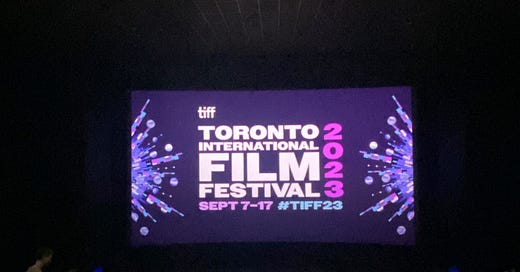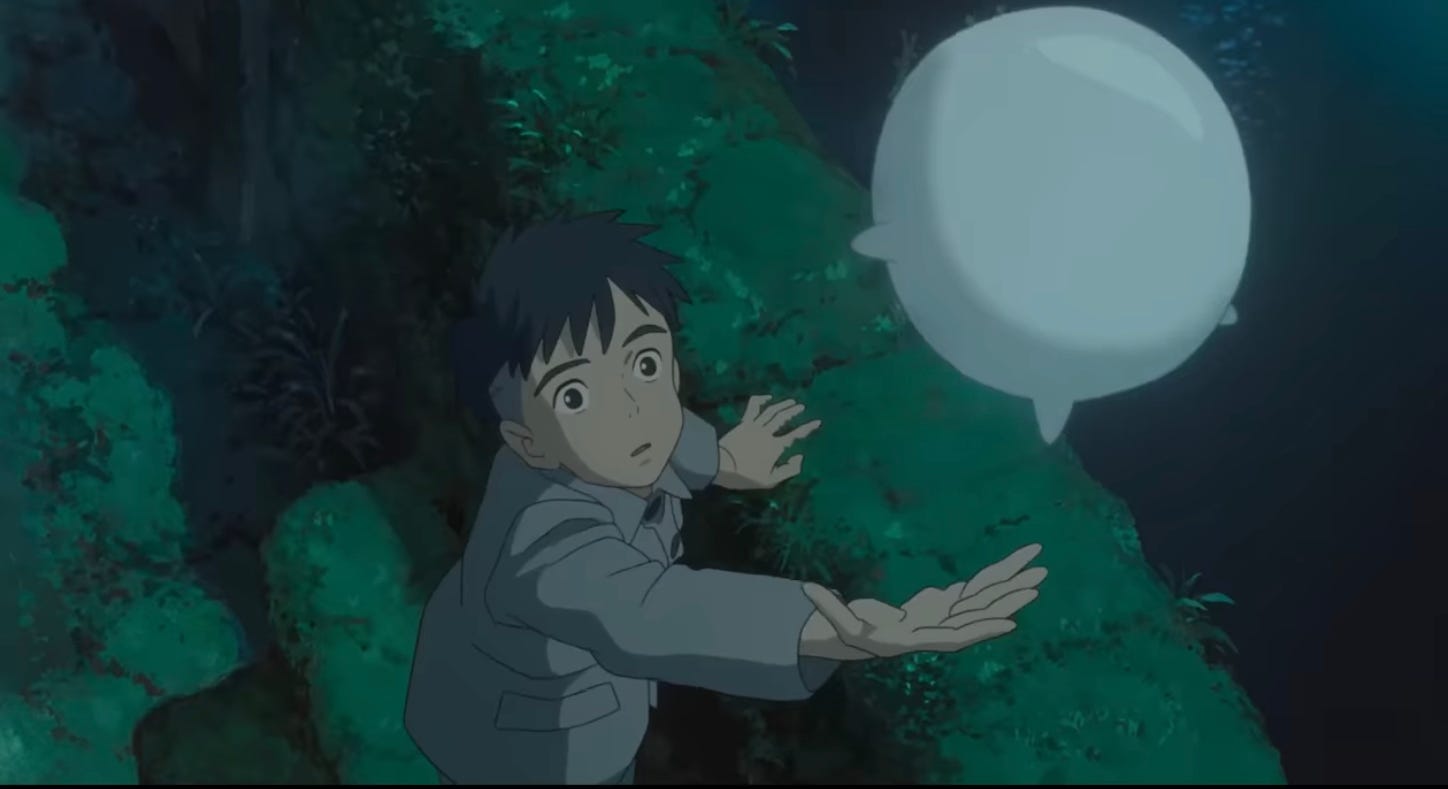TIFF Dispatch #2 & The Third Point
Jay, Blair and Lino talk The Boy and the Heron along with an essay by Jack about what we focus on when we watch a movie
Remember yesterday when I said I was going to get this post out there in the early afternoon? Well, I’m starting this at 10:30 P.M. so you should think of me as a liar.
The podcast covers yesterday, Friday September 8th, 2023. As the three will explain, they watched fewer movies than they did Thursday. Really just one, The Boy and the Heron, but fortunately Blair was able to see more and fill in the gap. Unfortunately, they protested with two arms in the air waving, “No, no I don’t want to write anything,” so to hear their thoughts you’ll have to listen in below. While Jay was catching up on beauty rest, Lino worked. They explain why Sweet Void is in Toronto outside watching great contemporary work from around the world.
Will throw out there we haven’t had a chance to mix the podcast and it does peak at times. This episode is worse than yesterday’s in that sense. I’d recommend playing at a medium-to-low volume. The iPhone recorded very clearly, just not in a controlled way.
Below the podcast will be Jay’s dispatch on The Boy and the Heron.
Below the dispatch is Jack’s essay on The Third Point.
All pictures below have been gathered by Jay and Lino.
(00:00-01:30) Introduction, Blair sometimes says stuff, Lino talks about the morning and a logistic nightmare.
(01:30-21:20) The Boy and the Heron, or is it actually called How Do You Live? Is Jay a weeb or just being silly? Blair gets the noise machine (laptop?) going around 02:30 and they get pretty distracted for a bit. Gets worse around 07:30, Jay especially loses her shit. Blair gets a few words in around 15:30 about the movie.
(21:20-28:00) After the movie Blair and Jay went to hang out with Lino who was working at a cafe. They talk about EPK work and other prep for weekend meetings. Lino had them today and you’ll hear how they went tomorrow. Jay describes rest of the day and new Airbnb.
(28:00-31:00) Blair talks shorts: “Dammi” with Riz Ahmed, “La Perra,” “Been There,” “Primetime Mother” and “Meteor.”
(31:00-36:30) NAGA, Blair gives their thoughts around 34:30 after Jay does a lot of interruptions.
(36:30-38:25) Outro, they have some more fun with the noise machine.
Dispatch
The Boy and the Heron
There’s a scene in Castle in The Sky where the castle falls apart brick by brick. It’s a mind blowing scene to watch as you watch in real time every small brick move and fall through the sky, it’s a marvel of animation. You can’t help but just be wowed by the pure spectacle of that scene, both the grand image of a castle falling apart, and the smaller image of little bricks flying through the sky.
This film has a million scenes in its runtime that blow that scene from Castle in The Sky away. It is so grand and epic in its scale for set pieces that you’re just left mentally fried at the sight of it all. I started choking up at how purely beautiful and spectacular some of these scenes were. It’s a flat out miracle that this movie exist and that it looks this gorgeous. The imagery and narrative context behind them are all so highly fantastical that at points you can’t help but feel as if you are watching a work of art that is being projected down to your subconscious from a different plane of existence.
I can’t believe that this film exists but I am more than happy that it does. Find it crazy that I have to wait two more months to watch it again. It’s going to to stay in my head as if it were a dream I had about going to another world that I can’t fully articulate the visuals to other people.
The Third Point
What is the most ideal expression of love? For Slavoj Žižek, it is not the usual image of a couple staring deeply and lovingly into each other’s eyes. No, in fact the eyes point in the same direction, toward something else.
True lovers look toward the Third Point.
Revolutionaries look toward the Third Point for they are comrades. Rowers on a ship face the same direction for they are shipmates. In a church, patrons face the cross for that’s where Christ died. Viewers in a cinema face the screen for that’s where the movie is.
Is an audience unified? Is the audience in love with themselves for the time and place they sit? Of what importance is the company one keeps?
A lot has been made of distractions in the cinema since the cell phone ingrained itself amongst consumers. In a dark theater, the light of the phone distracts from the screen. Someone in the front row will be seen by everyone behind. No matter how discrete, light leaks. Light leak leaves an impression on the eyes it touches. Looking back toward the Third Point, there is contamination in the distraction. As in a church during sermon when a child makes a joke to another “quietly,” but in such fashion that everyone hears.
When I saw Bennett Miller’s Foxcatcher in December of 2014 I was a wreck. I hadn’t slept in twenty-four hours and it was the second night in a row I drove an hour to see a movie in theaters past 10pm. I snorted concerta to keep myself awake and drove for probably three or four hours each day of my induced wake. In the theater, I wasn’t tired at all. The Main Art Theater in Royal Oak, MI (now closed, sadly) was completely packed. Probably two hundred people. In the long silences where Channing Tatum’s character had to lose weight rapidly, I heard the audience, popcorn hitting the floor, their kindred anxiety. At that point I called it my favorite movie of the year.
I tried watching Foxcatcher a year later. Either fall of 2015 or early winter of 2016. I was in the theater of an apartment building friends lived in. Other friends were in town and the movie was agreed upon. During the movie, people talked over it and to each other, made jokes. Many of the jokes were mean and one friend got upset. We stopped the movie as they tore us all a new one.
A year ago I saw Foxcatcher in my apartment alone. I wanted to love it, as I’ve returned to Miller’s Moneyball over and over and found myself entertained at more or less the same points each time. Not here. The silences I found dull. In the theater, I believed the lack of sound to maintain meaning. At home, the same silences appeared to be empty absences, a piece of cultural nihilism. “A true story, a real death, what a tragedy.” Maybe capitalist realism par excellence, the exact kind of empty, austere drag that the academy and twitter reviewers love to hype up. I believed myself to have been caught up in the hype, a naive freshman at art school. Strung out and stupid.
A few days ago in the Substack post, “What Are Movies For?” I described the relation between art-object and subject as a kind of scale. When a viewer goes into a movie, different circumstances impact the relationship one has with the art-object, impacting the art itself. The circumstances and willingness to meet what the art-object demands is a scale of immediacy.
What role does the audience play? In my first experience with Foxcatcher I was caught up in the crowd and the cultural environment. The second time, personal drama interfered so much with the movie it was talked over and turned off. The final uninterrupted viewing, I was by myself and found ambivalent.
The Third Point does not change. The art-object is always the same. In this way, there are objective aspects to art.
However, in many ways a culture is what breeds an art-object. The culture is the atmosphere, the sun. Or to continue with the plant metaphor I used yesterday, it is the soil the seed is planted in.
You can have an artful relationship by yourself and with an object, but there is no love without a third. The Third Point refers not only to the relationship the subject has with an art-object, but the relationship built when there are multiple subjects. The row crew experiences the same moment of physical exhaustion together and that’s how their relationships develop. Churchgoers next to each other have their belief which obliges them to look at their Third Point. Revolutionaries have their ideologies and ambitions. Football players on the same team run toward the same field goal.
For movies, is the Third Point altered when most are not viewing the art-object together?
It’s clear allegiances can still form over the same art-object when subjects experience it at different points in time. The Vulgar Auteurism wave of criticism, for instance. Though there were some general movies appraised against the mainstream consensus that the Vulgar Auteurists mostly agreed upon or focused on with their criticism, for the most part those critics aligned never met each other. Or watched the movies they loved so much with one another. Many had seen Miami Vice or Resident Evil: Retribution at home after their initial theatrical releases. These aren’t entirely “appraisals,” rather, “reappraisals.”
It’s obvious streaming hurts cultural longevity to new releases. It’s been commented on a million times at this point, but when Netflix dumped the latest season of Stranger Things all on the same day it limited the show’s ability to create lasting conversation. Succession and The Idol (in very different ways) were able to create sustained conversation and excitement (or trepidation) due to their gradual episodic releases at the same time each week, the classic and proven method television is known for.
Traditional gradual and episodic releases for television works because audiences, though distanced by space, experience the same art-object at the same time.
Theaters work at building immediacy and arguably better than episodic television releases due to the confinement to physical structures at a specific time and place. Financially, there aren’t a lot of unknowns in the business outside how you get an audience into the theater. The actual business structure has existed and evolved over a hundred years and the audience data is out there.
Part of their structure involves audiences viewing the movie at the same time in the same place. They gather together in matching outfits and sit around each other for a hundred minutes. Audiences will remember where they were when they saw Greta Gerwig’s Barbie or Christopher Nolan’s Oppenheimer because they had the rare opportunity to participate in a cultural event. A time when most consumers want to stare in the same direction at the same Third Point. Because of this, audiences feel greater immediacy with these two movies than most movies get. Even if found ambivalent or hating, the subject’s relation with the art-object is immediate and powerful.
Is there a way to best situate yourself in a theater so you have the greatest odds of falling in love? A joke my film literature teacher made a lot in high school that I often repeat is, “If you sit in the front, you get the movie first.” It treats the art experience as a competition and in a way it is. You call the student in the front the teacher’s pest, right? The quarterback is usually positioned in the center of the team and gets the most attention.
Perhaps the “best way” is to put yourself in situations where it is possible to fall in love in the first place. There can be a Third Point as it’s not just you and the movie. There’s an audience you can call your comrades.









